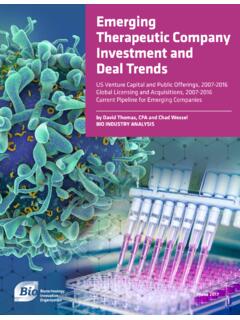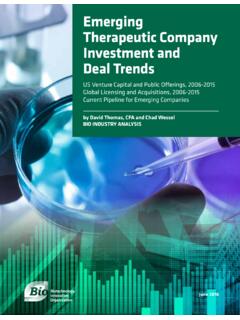Transcription of Clinical Development Success Rates 2006-2015 - BIO
1 Clinical Development Success Rates 2006-2015 June 2016 BiomedtrackerPharma intelligence | About BIOBIO is the world s largest trade association representing biotechnology companies, academic institutions, state biotechnology centers and related organizations across the United States and in more than 30 other nations. BIO members are involved in the research and Development of innovative healthcare, agricultural, industrial and environmental biotechnology products. BIO also produces the BIO International Convention, the world s largest gathering of the biotechnology industry, along with industry-leading investor and partnering meetings held around the BiomedtrackerBioMedTracker, a subscription-based product of Informa, tracks the Clinical Development and regulatory history of investigational drugs to assess its Likelihood of Approval (LOA) by the FDA.
2 BioMedTracker is populated in near real-time with updated information from press releases, corporate earnings calls, investor and medical meetings and numerous other sources. About AmplionAmplion is the leading biomarker business intelligence company, and its flagship product BiomarkerBase , along with consulting services and free reports, deliver insights that inform key strategic decisions for drug and diagnostic test developers. Since 2012 Amplion has helped large and small companies alike make the best use of biomarkers in advancing precision therapeutics and next generation diagnostics.
3 BiomarkerBase is a subscription-based service that tracks biomarker usage in Clinical trials, drug labels, and tests (including laboratory-developed, FDA-cleared, and FDA-approved tests). BiomarkerBase is updated weekly with information from these sources and publications, using supervised machine learning algorithms for natural language processing (Amplion BiomarkerEngine) to identify biomarkers. 2 | BIO Industry AnalysisExecutive SummaryThis is the largest study of Clinical drug Development Success Rates to date. Over the last decade, 2006-2015 , a total of 9,985 Clinical and regulatory phase transitions were recorded and analyzed from 7,455 Development programs, across 1,103 companies in the Biomedtracker database.
4 Phase transitions occur when a drug candidate advances into the next phase of Development or is suspended by the sponsor. By calculating the number of programs progressing to the next phase vs. the total number progressing and suspended, we assessed the Success rate at each of the four phases of Development : Phase I, II, III, and regulatory filing. Having phase-by-phase data in hand, we then compared groups of diseases, drug modalities and other attributes to generate the most comprehensive analysis yet of biopharmaceutical R&D Success . This work was made possible due to the years of Clinical program monitoring and data entry by Informa s Biomedtracker service.
5 BIO has long partnered with Biomedtracker to calculate Success Rates based on this data. More recently, BIO and Biomedtracker partnered with Amplion, the inventors of BiomarkerBase, to analyze the effects of biomarkers in Clinical trial takeaways: The overall likelihood of approval (LOA) from Phase I for all developmental candidates was , and for all indications outside of Oncology. Rare disease programs and programs that utilized selection biomarkers had higher Success Rates at each phase of Development vs. the overall dataset. Chronic diseases with high populations had lower LOA from Phase I vs.
6 The overall dataset. Of the 14 major disease areas, Hematology had the highest LOA from Phase I ( ) and Oncology had the lowest ( ). Sub-indication analysis within Oncology revealed hematological cancers had 2x higher LOA from Phase I than solid tumors. Oncology drugs had a 2x higher rate of first cycle approval than Psychiatric drugs, which had the lowest percent of first-cycle review approvals. Oncology drugs were also approved the fastest of all 14 disease areas. Phase II Clinical programs continue to experience the lowest Success rate of the four Development phases, with only of developmental candidates advancing to Phase intelligence | BIO Industry Analysis | 3 Disease areas covered in this report: Allergy Autoimmune Cardiovascular Chronic High Prevalence Diseases Endocrine Gastroenterology Hematology Infectious Disease Metabolic Neurology Oncology Ophthalmology Psychiatry Rare Diseases Respiratory Urology4 | BIO Industry AnalysisTable of ContentsIntroduction.
7 6 Phase Success and Likelihood of Approval (LOA) Overall ..7 Phase Success and Likelihood of Approval (LOA) by Disease ..8 Oncology and Non-Oncology Diseases ..13 Rare and Chronic High Prevalence Disease ..16 Patient Selection Biomarkers ..18 Phase Success and Likelihood of Approval (LOA) by Drug Classification ..20 Discussion ..22 Methods ..24 References ..26 BIO Industry Analysis | 5 IntroductionThis study aimed to measure Clinical Development Success Rates to strengthen benchmarking metrics for drug Development . To measure Success Rates for investigational drugs, we analyzed individual drug program phase transitions from January 1, 2006 to December 31, 2015.
8 For the ten years studied, 9,985 transitions in the Biomedtracker database were analyzed. A phase transition is the movement out of a Clinical phase for example, advancing from Phase I to Phase II Development , or being suspended after completion of Phase I Development . These transitions occurred in 7,455 Clinical drug Development programs, across 1,103 companies (both large and small), making this the largest study of its kind. With this broad set of data, we aimed to capture the diversity in drug Development across levels of novelty, molecular modalities, and disease company-sponsored, FDA registration-enabling Development programs were considered; investigator-sponsored studies were excluded from this analysis.
9 A more detailed description of the data collection, composition, and analysis methodology are described at the end of this report under Methods. Individual Phase transition Success Rates were determined by dividing the number that advanced to the next phase by the total number advanced and suspended. This advanced and suspended number is often referred to as n in this report, and should be taken into account when drawing conclusions from the Success rate results. One of the key measures of Success used in this report is the Likelihood of Approval (LOA) from Phase I.
10 This LOA Success rate is simply a multiplication of all four Phases Success Rates , a compounded probability calculation. For example, if each phase had a 50% chance of Success , then the LOA from Phase I would be x x x = | BIO Industry AnalysisPhase Transition Success and Likelihood of Approval (LOA) - OverallConsistent with previous studies of drug Development phase transition Success Rates , we found Phase II Success Rates to be far lower than any other Phase I and III Rates were substantially higher than Phase II, with Phase I slightly higher than Phase III.

















